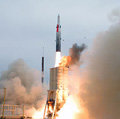
India added another destructive weapon to its nuclear warhouse when it successfully test fired the native developed long-range surface-to-surface missile Agni III on Wednesday capable of penetrating to a range of 3000 km deep inside the China. This is the third flight test in the series of the Agni III missile.
The test was conducted at 09:56 hrs today from the Wheeler Island off Orissa coast, approximately 150 km from the state capital Bhubaneshwar. India maintains a missile testing facility on the island.
The intermediate range ballistic missile (IRBM) was test-fired from a mobile launcher from the launch complex (LC-4) of the integrated test range (ITR), defence sources said.
A 17 metre long with 2 metres in diameter weighing about 50 tonnes and carrying a payload of 1.5 tonnes, the Agni III missile is a two stage solid propellant system.
Taking a flight at a height of 350 km with a velocity of more than 4000 metre/second, the missile hit the target in a calculated time of 800 seconds.
The Missile system is equipped with sophisticated Navigation, Guidance and Control systems including advanced distributed architecture based on Board Computer Systems for its guidance.
The electronic system is so developed to protect the missile from higher vibration, thermal and acoustic effects.
The Agni missile also scripted its name in the history as for the first time a high performance indigenous Ring Laser Gyro based navigation system is tested in it.
The official said, “It was a text book launch. All the subsystems of the Missile functioned in a copybook manner giving an outstanding integrated performance of the Missile in terms of range and accuracy.”
“The Missile re-enters into the atmosphere with a very high velocity and experiences a deceleration of more than 35 g and a temperature of more than 2500 °C,” said Avinash Chander, the Agni programme director.
The most significant development with Agni III is its Rail Mobile System which makes it capable of being launched from any where in India.
The Agni-3 missile was first test-fired on July 9, 2006 but owing to cascaded failure of booster flex nozzle controller it failed to meet its mission target.
However, during the second test conducted about a year later on April 12, 2007, the entire flight path of 15 minutes duration validated all mission objectives.
Agni-III is the country's first indigenous solid fuel missile that is compact and small enough for easy mobility and can be easily deployed on a variety of surface and sub-surface platform.
|
|
Read More: Bhubaneshwar


Comments: